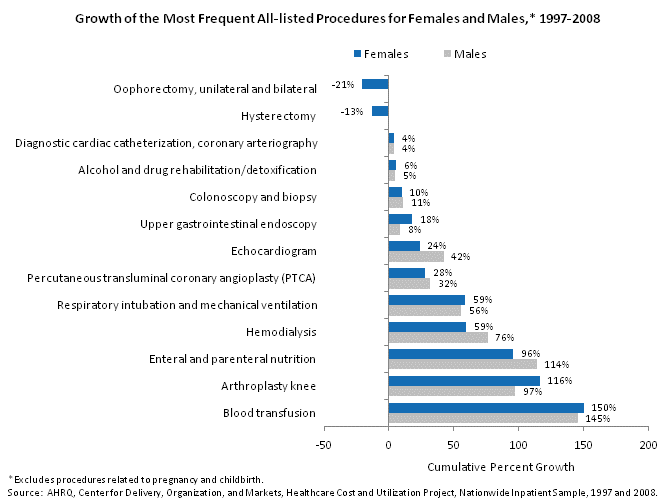TABLE OF CONTENTS
HIGHLIGHTS
INTRODUCTION
HCUP PARTNERS
1. OVERVIEW
2. DIAGNOSES
3. PROCEDURES
4. COSTS
5. MHSA
SOURCES/METHODS
DEFINITIONS
FOR MORE INFO
ACKNOWLEDGMENTS
CITATION
FACTS & FIGURES 2008 PDF
|
EXHIBIT 3.3 Most Frequent All-listed Procedures by Sex
Number of Discharges, Percent Distribution, and Rank of the Most Frequent All-listed Procedures for Inpatient Hospital Stays Excluding Pregnancy and Childbirth, by Sex, 2008
| ALL-LISTED CCS PROCEDURES |
NUMBER OF DISCHARGES IN THOUSANDS |
PERCENT OF DISCHARGES WITH A PROCEDURE |
RANK |
| MALES |
FEMALES |
MALES |
FEMALES |
MALES |
FEMALES |
| Discharges with a procedure† |
8,565 |
9,451 |
100.0% |
100.0% |
|
|
| Blood transfusion |
1,177 |
1,545 |
13.7 |
16.4 |
1 |
1 |
| Diagnostic cardiac catheterization, coronary arteriography |
923 |
598 |
10.8 |
6.3 |
2 |
4 |
| Respiratory intubation and mechanical ventilation |
768 |
676 |
9.0 |
7.2 |
3 |
3 |
| Upper gastrointestinal endoscopy |
568 |
687 |
6.6 |
7.3 |
4 |
2 |
| Percutaneous transluminal coronary angioplasty (PTCA) |
501 |
256 |
5.9 |
2.7 |
5 |
16 |
| Echocardiogram |
439 |
400‡ |
5.1 |
4.2 |
6 |
7 |
| Hemodialysis |
414 |
379‡ |
4.8 |
4.0 |
7 |
8 |
| Enteral and parenteral nutrition |
284 |
282‡ |
3.3 |
3.0 |
8 |
13 |
| Arthroplasty knee |
259 |
426 |
3.0 |
4.5 |
9 |
6 |
| Alcohol and drug rehabilitation/detoxification |
257 |
120 |
3.0 |
1.3 |
10 |
36 |
| Colonoscopy and biopsy |
244 |
342 |
2.8 |
3.6 |
13 |
10 |
| Hysterectomy |
— |
511 |
— |
5.4 |
— |
5 |
| Oophorectomy, unilateral and bilateral |
— |
374 |
— |
4.0 |
— |
9 |
† Excludes procedures related to pregnancy and childbirth and a small number of discharges (111,000 or 0.3 percent) with missing sex.
‡ Female discharges are not statistically different from male discharges at p‹0.05.
Source: AHRQ, Center for Delivery, Organization, and Markets, Healthcare Cost and Utilization Project, Nationwide Inpatient Sample, 2008. |
When procedures related to childbirth and newborns are excluded, males and females received similar procedures.
- Blood transfusion was the most common procedure for both sexes when childbirth and liveborn infant procedures are excluded. Transfusion occurred in 13.7 percent of all procedure-related stays for males and 16.4 percent of stays for females.
- For procedures common to both males and females, some procedures occurred more frequently in one sex:
- Two heart-related procedures—diagnostic cardiac catheterization and PTCAs—were performed more often for males than females. Diagnostic cardiac catheterization was performed in 10.8 percent of male discharges and 6.3 percent of female discharges in 2008 and was ranked as the second most frequent procedure in men and the fourth most frequent procedure in women.
- PTCAs were performed in 5.9 percent of male stays and 2.7 percent of female stays. PTCA was the fifth most common procedure for men and the sixteenth most common for women.
- Males also underwent more respiratory intubation and mechanical ventilation (9.0 percent of stays) than females (7.2 percent of stays). The procedure ranked third for both sexes.
- Males received alcohol and drug rehabilitation/detoxification (3.0 percent of male stays) more than females (1.3 percent of female stays). Alcohol and drug rehabilitation/detoxification ranked tenth for males and thirty-sixth for females.
- Females received blood transfusion, upper gastrointestinal endoscopy, colonoscopy and biopsy, and arthroplasty of the knee more often than males.
- For all other top ranking procedures (echocardiogram, hemodialysis, and enteral and parenteral nutrition), there was little difference between males and females in the volume of procedures performed.
- Hysterectomy and oophorectomy were the fifth and ninth most common procedures for females, respectively.

Growth of the most frequent all-listed procedures for females and males, 1997 through 2008. Bar chart. Cumulative percent growth. Oophorectomy, unilateral and bilateral: females: -21%. Hysterectomy: females: -13%. Diagnostic cardiac catheterization, coronary arteriography: females: 4%; males: 4%. Alcohol and drug rehabilitation/detoxification: females: 6%; males: 5%. Colonoscopy and biopsy: females: 10%; males: 11%. Upper gastrointestinal endoscopy: females: 18%; males: 8%. Echocardiogram: females: 24%; males: 42%. Percutaneous transluminal coronary angioplasty (PTCA): females: 28%; males: 32%. Respiratory intubation and mechanical ventilation: females: 59%; males: 56%. Hemodialysis: females: 59%; males: 76%. Enteral and parenteral nutrition: females: 96%; males: 114%. Arthroplasty knee: females: 116%; males: 97%. Blood transfusion: females: 150%; males: 145%. Note: Excludes procedures related to pregnancy and childbirth.
From 1997 to 2008, all discharges grew by 15 percent and discharges with a procedure grew by 18 percent. Growth varied widely among common procedures, but less so between females and males within a given procedure.
- The number of discharges for blood transfusion, the most frequent procedure for both sexes, was among the fastest growing common procedures since 1997, increasing by 150 percent for females and 145 percent for males.
- Other rapidly growing procedures for both females and males were arthroplasty of the knee (116 and 97 percent, respectively), enteral and parenteral nutrition (96 and 114 percent, respectively), hemodialysis (59 and 76 percent, respectively), and respiratory intubation and mechanical ventilation (59 percent for females and 56 percent for males).
- Colonoscopy, alcohol and drug rehabilitation/detoxification, and diagnostic cardiac catheterization grew slowly or remained stable for both females and males.
- Although hysterectomies and oophorectomies increased during the 5-year period from 1997-2002, these female-specific procedures declined in subsequent years. Over the 1997 to 2008 period, hysterectomies decreased by 13 percent and oophorectomies by 21 percent.
Previous Next
|